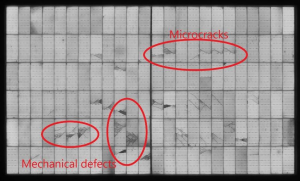A. Quality of modules
It is important to verify the procured modules meet the nameplate requirements and that are not significantly damaged during their transportation from the production house to the plant location. A sample of the modules from the batch is tested with flash tests and electroluminescence to confirm the quality and performance during installation. After careful assessment, modules are classified into one of four classes; A, B, C, and D as per the presence of defects.

B .Intermediate and final site inspection
The technical quality of the installation is assessed through intermediate and final field inspections according to pre-defined regulations and contractual agreements. Some of the major tasks include monitoring plant construction, critical inspection and fault detection on the system design, components, construction, and performance testing. Risk analysis and technical advice on the installation are provided after detailed activities, including
- Visual check of key components (mounting structure, PV modules, Inverters, AC, DC cables, etc.).
- Execution of measurements (to identify damaged PV modules, distance between modules, module angles, DC/AC string measurements).
- Inverters, string combiner box (SCB), transformers, high tension (HT) panel, ACDB, weather station, drainage, roads, module mounting system (MMS), vegetation, distribution panel (DP) structure, and transmission line.
- Drone thermography, visual inspection, PIV string, Pyranometer data validation.
- Confirmation of compliance with national and international standards, safety-relevant acceptance inspection, post-commissioning services, and completion verification.
